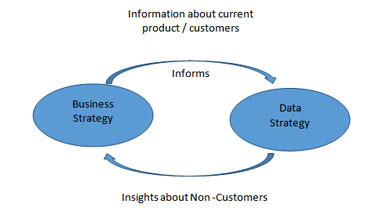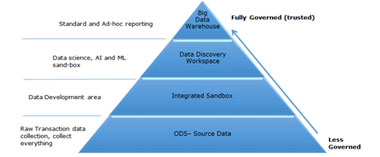THANK YOU FOR SUBSCRIBING
Editor's Pick (1 - 4 of 8)

Creating an effective big data strategy that delivers business value
Dnyanesh Prabhu, Director, Data Management and Conversions COE Global Services, Fiserv


Dnyanesh Prabhu, Director, Data Management and Conversions COE Global Services, Fiserv
Business units (BU) with strong data literacy may require access to raw and un-formatted data so that they can develop their own products. Whereas BUs with less data literacy will require access only to highly formatted data/reports/dashboards.
Legacy data platforms based on relational databases are not optimized to ingest and process a variety of data.
A modern data platform should have the following characteristics;
• It can ingest internal and external data of various formats
• It can process large volumes of data in a cost-effective method
•It can support batch and real-time processing of data
•It can support BI/analytics and advanced analytics solutions
4. Deliver key functionalities as soon as possible
“I don’t look to jump over 7-foot bars; I look around for 1-foot bars that I can step over.”- Warren Buffet
Gone are the days when big programs were executed over multiple years to deliver EDW and BI solutions. With modern big data capabilities like Hadoop, it is easy to fall in a trap and focus on ingesting all the available internal and external data in a data lake. Instead, aim to deliver business value as early as possible by ingesting data only from data sources which will be required to the current project/program. Data end products should be released as early as possible using an MVP (Minimum Viable Product) approach where the focus will be on delivering key functionalities to customers as early as possible.
 The first use case in the program should be a trivial and simple use-case and should not be the most important and the most complex project. More often than not, the most important and complex projects run into time/effort over-run and if you do not have any success to show prior to that, there is a good chance that business may lose confidence, and shut down the entire program.
The first use case in the program should be a trivial and simple use-case and should not be the most important and the most complex project. More often than not, the most important and complex projects run into time/effort over-run and if you do not have any success to show prior to that, there is a good chance that business may lose confidence, and shut down the entire program.
 By starting with a small and trivial task, you will get an opportunity to implement necessary tweaks/changes in people/process without a big impact on the overall program. The focus should be on incrementally delivering multiple small improvements. When individually considered, these small improvements may feel insignificant, but when combined together, they can deliver big value.
5. Implement a change management program
“Would you persuade, speak of interest and not of reason.” – Benjamin Franklin
Creating actionable insights is only half the battle won. You need to have a necessary set up from the business side to take actions on those insights. That means changing the way the business operates and embedding analytics and insights based decision making in organization processes and structure. While it is important to centralize core capabilities like data engineering and analytics, use and consumption of data should be democratized. Having business buy -in and involving business from the inception of the project, provides necessary impetus for business to take action on the insights provided by your data program.
You can help your business create and establish a successful big data practice by following the above five actions. Such steps can prove to be a cornerstone to transforming the business into a truly data driven organization and provide the “Right Data to the Right People in the Right Way”.
By starting with a small and trivial task, you will get an opportunity to implement necessary tweaks/changes in people/process without a big impact on the overall program. The focus should be on incrementally delivering multiple small improvements. When individually considered, these small improvements may feel insignificant, but when combined together, they can deliver big value.
5. Implement a change management program
“Would you persuade, speak of interest and not of reason.” – Benjamin Franklin
Creating actionable insights is only half the battle won. You need to have a necessary set up from the business side to take actions on those insights. That means changing the way the business operates and embedding analytics and insights based decision making in organization processes and structure. While it is important to centralize core capabilities like data engineering and analytics, use and consumption of data should be democratized. Having business buy -in and involving business from the inception of the project, provides necessary impetus for business to take action on the insights provided by your data program.
You can help your business create and establish a successful big data practice by following the above five actions. Such steps can prove to be a cornerstone to transforming the business into a truly data driven organization and provide the “Right Data to the Right People in the Right Way”.
 The first use case in the program should be a trivial and simple use-case and should not be the most important and the most complex project. More often than not, the most important and complex projects run into time/effort over-run and if you do not have any success to show prior to that, there is a good chance that business may lose confidence, and shut down the entire program.
The first use case in the program should be a trivial and simple use-case and should not be the most important and the most complex project. More often than not, the most important and complex projects run into time/effort over-run and if you do not have any success to show prior to that, there is a good chance that business may lose confidence, and shut down the entire program.
 By starting with a small and trivial task, you will get an opportunity to implement necessary tweaks/changes in people/process without a big impact on the overall program. The focus should be on incrementally delivering multiple small improvements. When individually considered, these small improvements may feel insignificant, but when combined together, they can deliver big value.
5. Implement a change management program
“Would you persuade, speak of interest and not of reason.” – Benjamin Franklin
Creating actionable insights is only half the battle won. You need to have a necessary set up from the business side to take actions on those insights. That means changing the way the business operates and embedding analytics and insights based decision making in organization processes and structure. While it is important to centralize core capabilities like data engineering and analytics, use and consumption of data should be democratized. Having business buy -in and involving business from the inception of the project, provides necessary impetus for business to take action on the insights provided by your data program.
You can help your business create and establish a successful big data practice by following the above five actions. Such steps can prove to be a cornerstone to transforming the business into a truly data driven organization and provide the “Right Data to the Right People in the Right Way”.
By starting with a small and trivial task, you will get an opportunity to implement necessary tweaks/changes in people/process without a big impact on the overall program. The focus should be on incrementally delivering multiple small improvements. When individually considered, these small improvements may feel insignificant, but when combined together, they can deliver big value.
5. Implement a change management program
“Would you persuade, speak of interest and not of reason.” – Benjamin Franklin
Creating actionable insights is only half the battle won. You need to have a necessary set up from the business side to take actions on those insights. That means changing the way the business operates and embedding analytics and insights based decision making in organization processes and structure. While it is important to centralize core capabilities like data engineering and analytics, use and consumption of data should be democratized. Having business buy -in and involving business from the inception of the project, provides necessary impetus for business to take action on the insights provided by your data program.
You can help your business create and establish a successful big data practice by following the above five actions. Such steps can prove to be a cornerstone to transforming the business into a truly data driven organization and provide the “Right Data to the Right People in the Right Way”.











